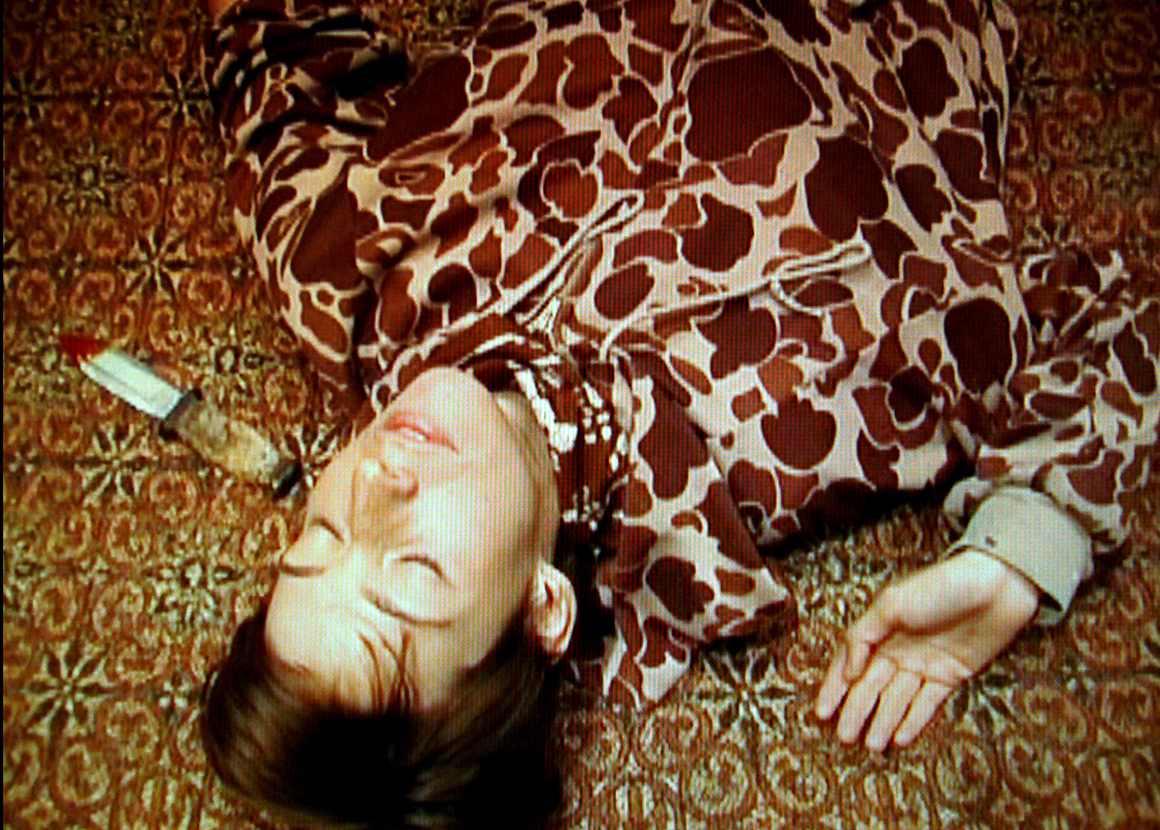START STOP. is a two part curatorial project on rhythmicity organized by Christof Migone which features and examines various manifestations of continuities and discontinuities, of finitude and infinitude. STOP., the determined terminal, the waning towards cessation—that final gasp of air. STOP., followed by a period adding closure to the arresting word. From January 24 to March 1, STOP. examines strategies of resolution and termination in the form of a heterogeneous mix of works that thrust the viewer towards the wall delimiting the finite and the infinite. The installations, objects and videos featured in STOP. plot endpoints and stage endgames. The appearance of corpses as well as the discussion of entrapment and mortality is broached with an implicit and incongruous irreverence. Whether marking an ultimate end or a momentary hold, STOP. acts as the snapshot of an incessant rhythm. The exhibition abounds in repetitions and multiplicities, all summoning abundance over paucity.
Curated by Christof Migone, Visiting Curator of Contemporary Art, 2007-2008
The Curator
Christof Migone is a multidisciplinary artist, curator and writer. His work and research delves into language, voice, bodies, performance, intimacy, complicity, incontinence, failure, repetition and endurance. The conceptual audio, video, performance, text, installation works he produces have been presented internationally. He writes theoretical and scholarly essays as well as experimental texts. The exhibitions and events he has curated since 1990 are an extension of his radio work which began in 1984. He completed a Ph.D. at New York University’s Department of Performance Studies. He currently lives and works in Montréal and teaches at Concordia University.
ADDITIONAL SOURCES OF INFORMATION
Migone, Christof. START STOP. Montreal : Leonard & Bina Ellen Art Gallery, 2008.
CloseThe Artists
Observing the shifts in location, form and meaning that the landscape undergoes as a result of his various manipulations, Patrick Beaulieu attempts to affect the very nature of objects, putting their frailty to the test. He explores the physical limits of the artwork as installations that bring together fragments of landscape that are animated by devices that transform and affect the sensitive matter that is exhibited. His work involves multimedia (sculpture, photography, video, Web) as well as live interventions directly inspired by the communities in which he chooses to enact his poetic gestures. Beaulieu’s installations have been presented in Singapore, South Korea, Mexico, Belgium and in Canada. He lives and works in Montreal.
THE WORK
Bruissement, 2007
Tree leaf, micro camera, LCD monitor, and electronic device
Bruissement is a work in a series that explores the slowness of gesture in sculpture. Through the use of a subtle electromechanical device, a leaf appears to be overcome by a minor spasm, a faint visual rustling, before the spectator’s gaze. In all its fragility, the leaf rises and settles, oscillating between the animate and the inanimate.
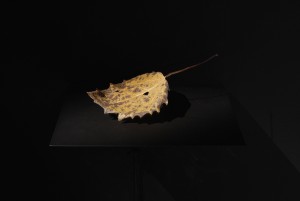
Patrick Beaulieu, Bruissement, 2007.
Courtesy of Art Mûr
Image: Paul Litherland
EXPLORE
- The ways in which this work questions notions of what is real, what is visible, and what is physical
- The numerous transformations that occur through Patrick Beaulieu’s use of technology in recreating and reframing a seemingly simple phenomenon.
A FEW QUESTIONS
- What is the effect of the electronic device in Bruissement?
- How does Patrick Beaulieu explore notions of perception?
ADDITIONAL SOURCES OF INFORMATION
Beaupré, Marie-Ève, “Pivoter. Se heurter. Résonner.,” Ex Situ, n° 6: 11-12.
Lamarche, Bernard, “La simplicité complexe,” Le Devoir, Saturday 30 and Sunday 31 October, 2004: E9.
Mavrikakis, Nicolas, “Jouer avec le feu,” VOIR, 1 March 2007: p. 37.
CloseSimone Jones (born in a Red Cross outpost in northern Ontario, Canada, 1966) has been making kinetic sculpture since 1989. Most recently, her work has expanded to include film, video and performance. Jones is currently an Associate Dean at the Ontario College of Art & Design. Lance Winn (born Kansas City, Missouri, 1970) received an MFA from the Cranbrook Academy of Art in 1996 and a BFA from the Rhode Island School of Design in 1993. He investigates different technologies used to reproduce images to expose where methods of capturing and distributing information might reveal certain desires and tendencies. Winn is currently an Assistant Professor of Art at the University of Delaware. Simone Jones and Lance Winn have collaborated on a series of image capture/projection machines since 2002 when they were both Visiting Assistant Professors of Art at Carnegie Mellon University, Pittsburgh.
THE WORK
Knock, 2006
Robotic video installation, 5 min. 22 sec.
Knock is a murder mystery in which the action of three actors is motivated by knocking, entrances, and exits through doors on opposite sides of a room. The knocking, coming from off-screen, activates the camera/projector to seek out its source, producing the space for the story. The seeking out of what is off-screen allows for a literally “fuller-picture” but leaves visual gaps that become a space for the unknown, or mystery.
EXPLORE
- The ways in which this work examines ideas such as view points and the act of viewing;
- The theatricality of camera movement; how narrative drives camera movement and also how camera movement drives narrative.
A FEW QUESTIONS
- When the camera/projector is activated in this piece, what is it “looking for”?
- In what ways does Knock focus both on the edges of the two-dimensional image and on the desire to see beyond the limits of the frame?
ADDITIONAL SOURCES OF INFORMATION
Walter Phillips Gallery: Simone Jones and Lance Winn, Knock
Allen, Jan, Ihor Holubizky, and Caroline Seck Langill, Machine Life. Kingston: Agnes Etherington Art Centre / Toronto: Koffler Centre, 2004.
Lamarche, Bernard, “Bruitages incorporés,” Le Devoir, November 27, 2000.
Mazzel, Rebecca. “Mutant Scribe: Lance Winn and his unsteady hand,” Detroit Metro Times, June 7, 2006.
CloseThérèse Mastroiacovo’s practice embraces a variety of mediums including; video, sound, installation, photography, sculpture, drawing, and performance. She teaches in both Computation Art and Studio Arts at Concordia University. She is presently on the boards of Optica, a centre for contemporary art, and Kore, an ensemble for experimental and contemporary music. She has exhibited her work locally and abroad. She lives and works in Montreal.
THE WORKS
Untitled (John Baldessari, 1972) 2002 – ongoing
Photocopies and liquid paper
This work uses as its raw material a piece by John Baldessari, “I will not make any more boring art” (1972). The “original” is a lithograph in which the artist writes out one sentence, the title of this work, over and over in the form of lines that a student might be given as punishment or a rule you are not aware of and must learn. In my work, I scanned, printed, and photocopied his work, and with the use of liquid paper, I traced out and covered over in each line of the sentence the word “boring”. The text now reads: “I will not make any more…art”. To date I have completed approximately 500 copies. (Thérèse Mastroiacovo)
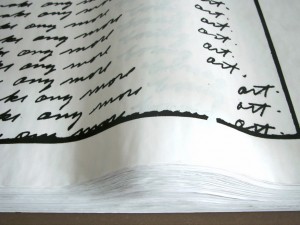
Thérèse Mastroiacovo, Untitled (John Baldessari, 1972), 2002 – ongoing.
Courtesy of the artist
EXPLORE
- Notions of appropriation and how Mastroiacovo uses an existing artwork to create a new one;
- Art as idea, artistic process as methodology, and the precarious relationship between art and its own definition.
A FEW QUESTIONS
- What effect does Thérèse Mastroiacovo’s shared authorship or collaboration have?
- While conceptual in nature, Untitled (John Baldessari, 1972) also has a very strong physical presence. How does our physical relationship to this piece affect our viewing of it?
ADDITIONAL SOURCES OF INFORMATION
Arnold, Martin. Corrine Carlson: Record Jacket ; Thérèse Mastroiacovo: Art
Now. Toronto: Mercer Union, 2007.
Ghaznavi, Corinna. hello fellow artists. Montreal: Optica, 2002.
Tousignant, Isa. Video Killed the Video Star. Hour, March 14 – March 20,
2002.
The American composer and performer Charlemagne Palestine is one of the exponents of what was known in New York City in the late 60s and 70s as the ‘downtown music scene’. He chose to subject minimalist concepts to extreme physical endurance and intense acoustic explorations; blurring the borders between concert and performance. In the 1970s, Palestine produced a seminal body of performance-based, psychodramatic videotapes in which he ritualistically used physicality, motion and sound to achieve an outward articulation of internal states. Intense and often violently charged, these exercises are characterized by a visceral enactment of physical and psychological catharses.
THE WORKS
Island Song / Island Monologue, 1976
Video projection, 31 min. 34 sec.
These two works confront confinement, isolation and powerlessness. In Island Song, Palestine straps a video camera to a motorcycle and then drives around the island as though searching for an escape. In Island Monologue, this theme is extended to an attempt to escape the island in a thick fog.
EXPLORE
- Ways in which Palestine uses physicality, motion, and sound to articulate internal states;
- Duration and the extension of the present moment.
A FEW QUESTIONS
- How is the viewer engaged in these two pieces?
- Do you find Island Song / Island Monologue humorous? If so, why? If not, why not?
ADDITIONAL SOURCES OF INFORMATION
Guzman, Antonio. Charlemagne Palestine: Sacred Bordello. London / New York: Black Dog Publishing, 2003.
CloseSamuel Roy-Bois is an artist, musician and performer. He is known for his large scale immersive installations, where the line between work of art and exhibition space is often blurred. Defining art as experience first, Roy-Bois conceives work as metafiction, through which he questions the complex relationship one has with architecture and the built environment. His work has been shown in Canada and abroad. In 2006,the Musée d’art contemporain de Montréal organized a solo exhibition of his work. He lives and works in Vancouver.
THE WORKS
J’ai entendu un bruit, je me suis sauvé, 2003
Drywall, wood, electric lighting, and paint
J’ai entendu un bruit, je me suis sauvé is inspired by the neoclassical architect Étienne-Louis Boullée’s utopian project, Newton’s Cenotaph (1784). The building, technically unrealizable at the time, would have been a gigantic, hollow sphere. The curved walls would have been pierced with holes, allowing light into the space in such a way as to be reminiscent of the starry sky. Boullée’s architecture proposed a metaphorical reversal of the natural order of things by presenting the cosmos contained within a human construction. J’ai entendu un bruit, je me suis sauvé proposes an “impoverished” version of Boullée’s project, a realized/realizable one inscribed more precisely in the everyday. We are in a place in which the distinction between the finite and the infinite becomes diluted and where it is difficult to determine where the exterior and the interior are situated.
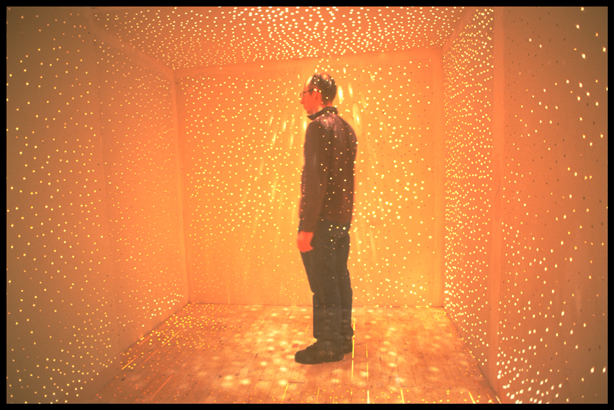
Samuel Roy-Bois, J’ai entendu un bruit, je me suis sauvé, 2003.
Courtesy of the artist
EXPLORE
- The relationship between this installation and the architecture and environment that surround it.
- Notions of isolation, (im)mobility, and visibility.
A FEW QUESTIONS
- How does Samuel Roy-Bois explore notions of interior, exterior, intimacy, and exposure?
- By what means does J’ai entendu un bruit, je me suis sauvé cause the viewer to reflect on memory and experience?
ADDITIONAL SOURCES OF INFORMATION
Anderson, Shannon. Burrow / Terrier: Janice Kerbel, Adriana Kuiper, Liz Magor, Samuel Roy-Bois. Oakville: Oakville Galleries / Joliette: Musée d’art de Joliette, 2007.
Godmer, Gilles. Samuel Roy-Bois : Improbable et ridicule. Montreal: Musée d’art contemporain de Montréal, 2006.
CloseHelen Tak works mainly with photography, video and sound. She is interested in the supernatural, human fears, strange behaviours and manias in a very wide sense. Her artwork deals with both the real and the imaginary and ranges in form from documentary to narrative and experimental. Her process begins when her imagination is triggered by a particular momentary experience; whether that is in a film, a news article, a meeting with a person, a phrase or a song. Her latest work delves into such themes as the threat from the unknown and the dark side of human nature. Helen Tak lives in Gothenburg.
THE WORKS
The Beginning, 2004
Video projection, 5 min. 23 sec.
Helen Tak’s The Beginning, an eerie and mysterious mood piece, moves from outside to inside scenes by way of a photograph of trees hanging on a living room wall. The stop motion animation utilized in the largely desolate scenes creates shimmering, pulsating sequences. The nocturnal permeates every frame and dialogue is replaced by exaggerated, intensified room tones and disparate sonic events. The video also, unbeknownst to the artist, pays homage to Michael Snow’s Wavelength.
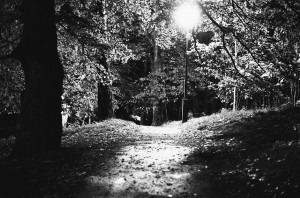
Helen Tak, video still The Beginning, 2004.
Courtesy of the artist
EXPLORE
- Sound and its materiality;
- The artist’s construction of narrative and the ways in which the viewer’s particpation in that construction is activated.
A FEW QUESTIONS
- What effect is created by the numerous still images in The Beginning?
- In what ways do non-synchronous sounds and images function together in The Beginning?







